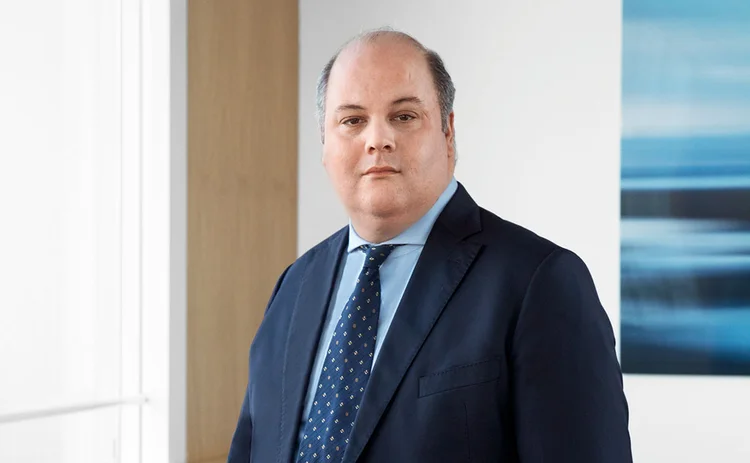
Investment house of the year: Amundi
Risk Awards 2021: When the pandemic hit, Amundi moved quickly to cut risk and raise liquidity

In an industry where performance is everything, telling portfolio managers to aim low is unusual. But that is exactly what Amundi did in February when Europe suffered its first serious outbreak of Covid-19.
Putting a lid on oversized bets early on was one of a number of steps that helped Europe’s largest asset manager get through the March turmoil without too much drama or damage to clients’ trust, according to Vincent Mortier, deputy chief investment officer.
“We said to our portfolio managers, ‘don’t be heroes’,” he says.
A severe market crisis, with all the volatility and uncertainty that brings, is not the time to be making bold bets, he explains.
“We prefer to abandon a little bit of performance to protect our funds and not to have a big negative outcome for our clients.”
Another defensive measure Amundi took before the emerging pandemic triggered a full-blown market crisis was to beef up liquidity buffers in all of its funds. The goal was to avoid being forced to gate or suspend any funds if markets gummed up.
The framework for responding to a market stress was developed at Amundi about four years earlier, based partly on stress-testing of assets and liabilities. That work made it easier to react quickly in February and March.
“It was very important to be agile and not to discuss strategies and not to negotiate fund by fund what we should do,” Mortier says. “So the preparation work we did and the investment we made into tools and processes were super-useful when the crisis happened.”
Those contingency plans sprang into action after Italy reported its first known cases of local transmission of Covid-19 on Friday, February 21.
We prefer to abandon a little bit of performance to protect our funds and not to have a big negative outcome for our clients
Vincent Mortier, Amundi
That weekend, after an internal discussion, Amundi decided to raise the liquidity buffers for its funds from what it calls level 1, meant for normal times, to level 2. It was also then that the firm resolved to cut risk in its multi-asset portfolios – specifically, to significantly reduce equity exposures – and to start close, daily monitoring of its funds.
Those decisions proved prescient, as the S&P 500 fell 3.4% the following Monday, February 24, sharply reversing its upward trend since the beginning of the year. By March 23, the index reached a multi-year low.
Before then, Amundi raised its buffers once more.
“Back in the last two weeks of March, the environment was so, so unpredictable and so difficult to manage, in particular as regards the modalities and the speediness of intervention by central banks and by governments,” Mortier explains.
In mid-March, the Federal Reserve was yet to come out with its game-changing announcement of unlimited asset purchases, and a steep ramping-up of emergency bond buying by the European Central Bank was also some days away in the future. So, with market liquidity still extremely low, Amundi decided to go to what it called level 2.2 liquidity.
“Level 3 [is] Armageddon. We were not yet at level 3,” Mortier says.
The level 1 and 2 liquidity buffers were predetermined and calibrated to ensure Amundi’s funds could meet redemption requests in normal and stressed market conditions. The new level 2.2 liquidity buffers were tailor-made on the fly for each fund, depending on the assets it held, Amundi’s view on the assets’ liquidity during the pandemic and the fund’s client base. The liquidity layer consisted of cash and liquid assets such as, for example, US Treasuries, German bunds, large-cap equities and some high-grade corporate bonds.

Although in hindsight the level 2 liquidity would have been sufficient, Amundi’s extra caution is explained by its firm belief that open-ended daily liquidity funds should never be gated. This stands in contrast to a view among many regulators and some asset managers that liquidity management tools, including redemption gates, are vital in times of market stress.
For Amundi, it is a question of fiduciary duty and client confidence, Mortier says. “When you gate a fund, you’re taking the investors hostage… You can create some very stressful or adverse situations for all those who might need the cash for good reasons.”
He adds: “If you are forced to gate a fund, it is because you have managed the fund’s assets and liabilities badly, or you have taken too much risk on illiquid positions.”
Mortier doesn’t think the reputational risk of using gates or suspensions – which are a more severe way to restrict redemptions – will ever disappear.
“Under the current framework, which is Ucits daily liquidity, I don’t see why it would go away. There is no reason why we should change our stance in that regard for the daily liquidity funds,” he says.
European mutual funds, officially called Undertakings for the Collective Investment in Transferable Securities, must allow investors to buy or sell shares at least twice a month but in practice most offer daily dealing.
We embarked from the start with the risk department as a partner
Vincent Mortier
Thanks to its larger liquidity cushions, Amundi made it through the market storm without having to gate or suspend any funds to cope with outflows. Some other firms did have to restrict redemptions in March.
According to the European Securities and Markets Authority, up to €100 billion ($121 billion) of European Ucits and alternative fund assets were subject to temporary suspension of redemptions and other liquidity management measures during the market stress. Data from the European Fund and Asset Management Association shows net outflows from Ucits funds totalled €313 billion, or nearly 3% of total assets, in March.
All the while, Amundi’s management kept a close eye on its funds through regular meetings with the risk function, the trading desk and the chief investment officers of its various business lines. “We embarked from the start with the risk department as a partner,” Mortier says, noting that, at 230 people, Amundi’s risk team is “quite large”.
In addition to monitoring its funds’ net flows and liquidity levels, Amundi analysed the leverage employed by portfolio managers to make sure they were not taking on more risk through derivatives to compensate for higher cash buffers.
The firm also did “deep dives” on some funds to understand certain risks, such as credit and country risks, as well as on some specific exposures across its funds – for example, its exposure to the energy sector.
“Thanks to these analyses and data coming from risk, we were able to have a dialogue with portfolio managers [about risk] in a very positive way,” Mortier says.
The crisis has resulted in much more interest and traction for the ESG approach across the board
Vincent Mortier
Amundi achieved its goal of avoiding substantial underperformance during the crisis. “On average, we performed like the average for our universe, for our peers,” Mortier says.
Data from Morningstar confirms this. The median performance of Amundi’s 926 European funds over the February-March period fell into the second quartile for its peer group. Its 25 US-domiciled funds did better on average, recording returns within the first quartile.
Although the Covid-19 crisis was the defining event of the year, it wasn’t the only notable development for Amundi. It launched a number of new products in 2020, even when it was still in fire-fighting mode.
A lot of the innovation revolved around investing with an environmental, social or governance (ESG) slant. For example, Amundi released a fund based on social bonds, a green bond fund focused on emerging markets and a fossil fuel-free, low-carbon index fund.
“The crisis has resulted in much more interest and traction for the ESG approach across the board,” Mortier says. “So it was fortunate that we were able to deliver things like this.”
Amundi also saw increasing demand for its funds of exchange-traded funds (ETFs) and mandates of ETFs in 2020 – something Mortier calls “a secular trend”.
“It is a good combination of active management, conviction-based, but implemented through ETFs, which is perceived by clients as low-cost, efficient and liquid,” he says. “It was very interesting to see teams working together – actively managed multi-asset funds’ teams, ETF teams, the quant team etc – to design products that fit this new need of clients and that can be implemented into funds or into discretionary portfolio mandates.”
The firm recently won a €335 million fund of ETFs mandate from an Austrian utility and a €50 million fund of ETFs mandate from a German pension scheme.
In October, Amundi opened a joint venture (JV) in China, capitalising on another area of growth. The tie-up with BOC Wealth Management, a subsidiary of the Bank of China, offers new wealth management products invested in liquid renminbi assets, with an initial focus on Chinese retail investors. Amundi is the majority shareholder – the first time a foreign player has acquired a majority stake in a Chinese asset management firm.
“The JV is a China-to-China venture, based on the Amundi IT system, investment processes, approach, risk framework etc, so it’s pretty unique,” Mortier says.
Only users who have a paid subscription or are part of a corporate subscription are able to print or copy content.
To access these options, along with all other subscription benefits, please contact info@risk.net or view our subscription options here: http://subscriptions.risk.net/subscribe
You are currently unable to print this content. Please contact info@risk.net to find out more.
You are currently unable to copy this content. Please contact info@risk.net to find out more.
Copyright Infopro Digital Limited. All rights reserved.
As outlined in our terms and conditions, https://www.infopro-digital.com/terms-and-conditions/subscriptions/ (point 2.4), printing is limited to a single copy.
If you would like to purchase additional rights please email info@risk.net
Copyright Infopro Digital Limited. All rights reserved.
You may share this content using our article tools. As outlined in our terms and conditions, https://www.infopro-digital.com/terms-and-conditions/subscriptions/ (clause 2.4), an Authorised User may only make one copy of the materials for their own personal use. You must also comply with the restrictions in clause 2.5.
If you would like to purchase additional rights please email info@risk.net
More on Awards
Market liquidity risk product of the year: Bloomberg
Bringing clarity and defensibility to liquidity risk in a fragmented fixed income market
FRTB (SA) product of the year: Bloomberg
A globally consistent and reliable regulatory standardised approach for FRTB
Best use of cloud: ActiveViam
Redefining high-performance risk analytics in the cloud
Best use of machine learning/AI: ActiveViam
Bringing machine intelligence to real-time risk analytics
Collateral management and optimisation product of the year: CloudMargin
Delivering the modern blueprint for enterprise collateral resilience
Flow market-maker of the year: Citadel Securities
Risk Awards 2026: No financing; no long-dated swaps? “No distractions,” says Esposito
Pricing and analytics: fixed income – Quantifi
Quantifi delivers high-performance, transparent and adaptable pricing and risk analytics for fixed income and credit markets
Derivatives house of the year: Citi
Risk Awards 2026: Rev up, RWAs down, as US bank gets back on track (with added XiNG and XiP)







